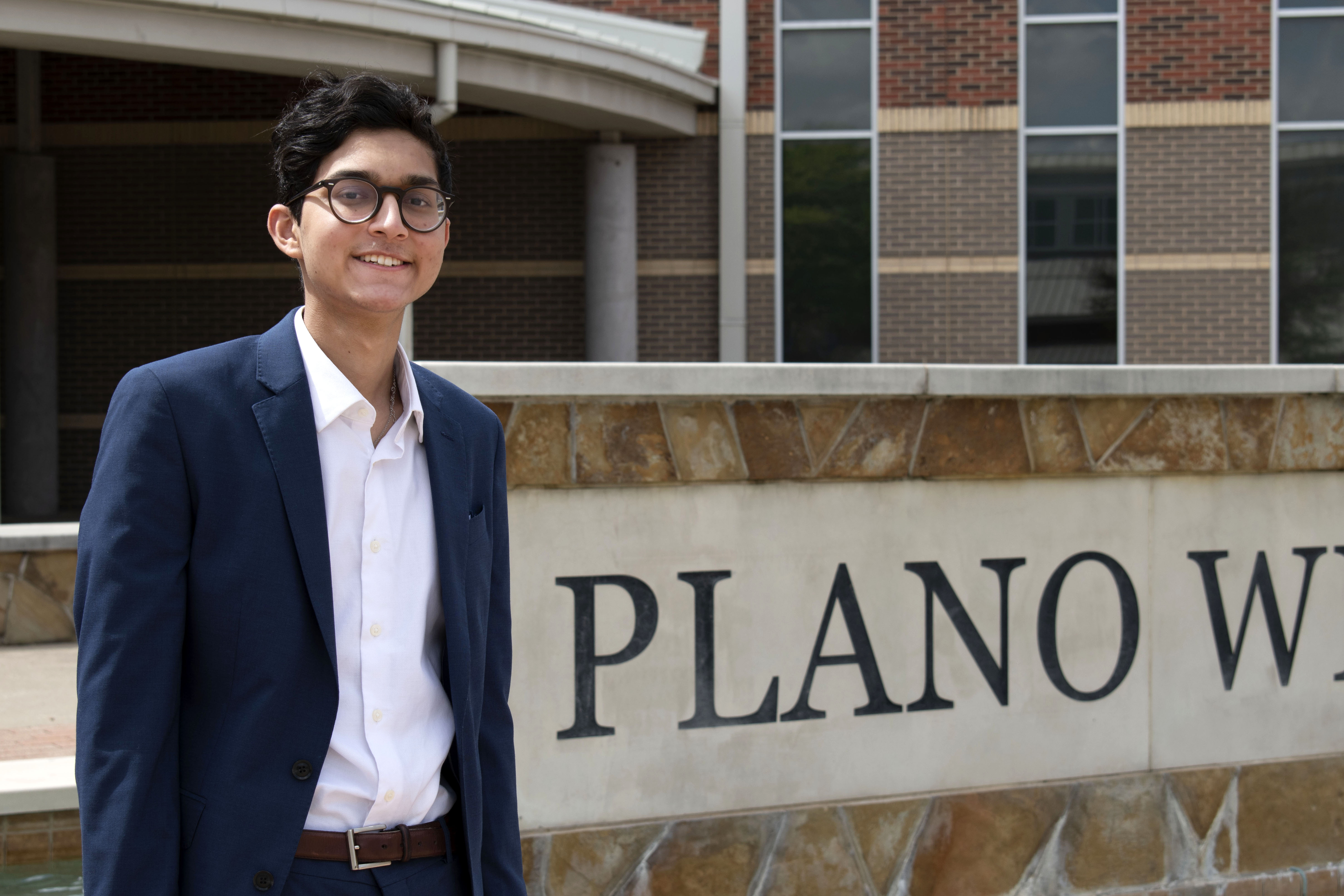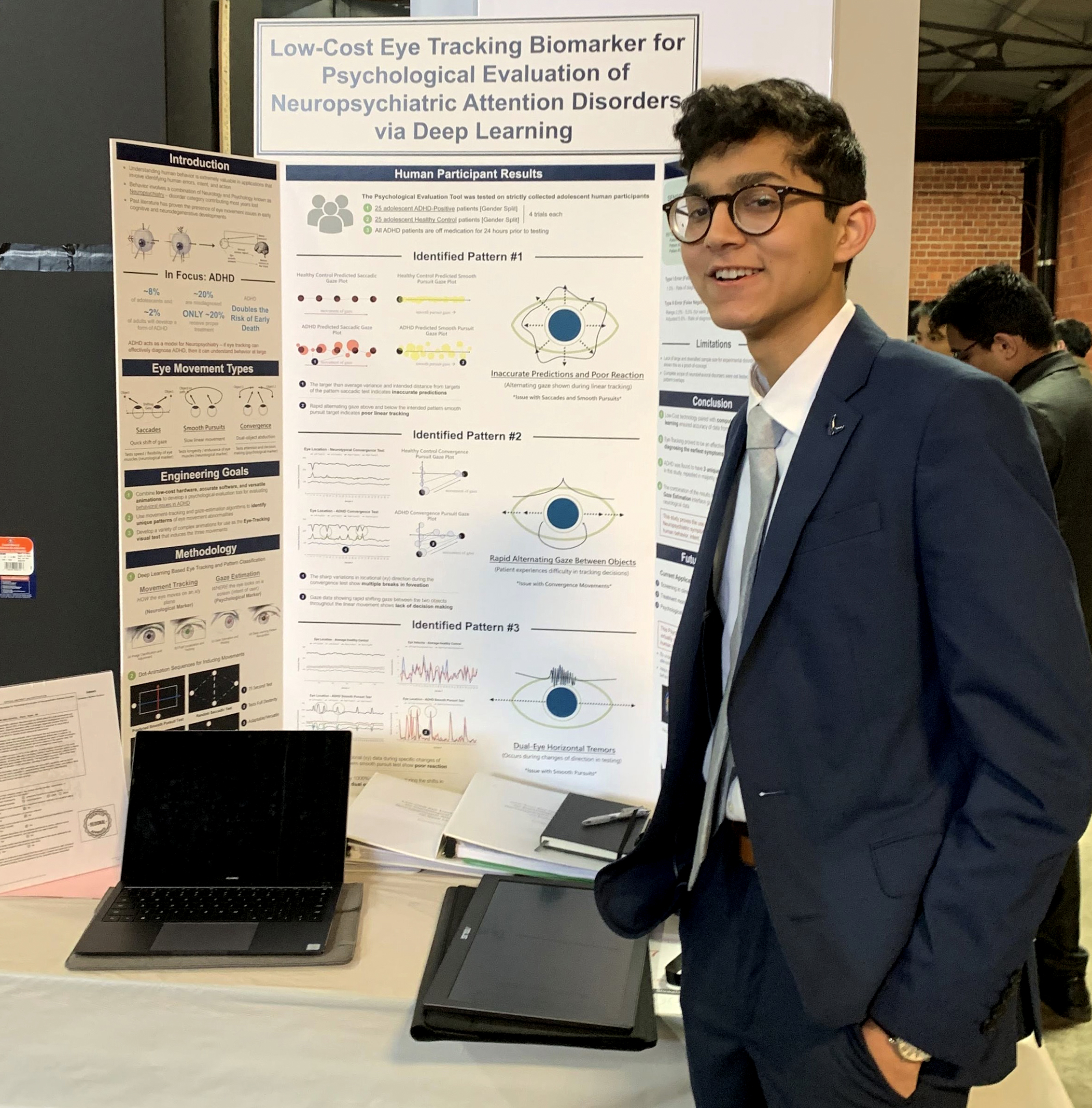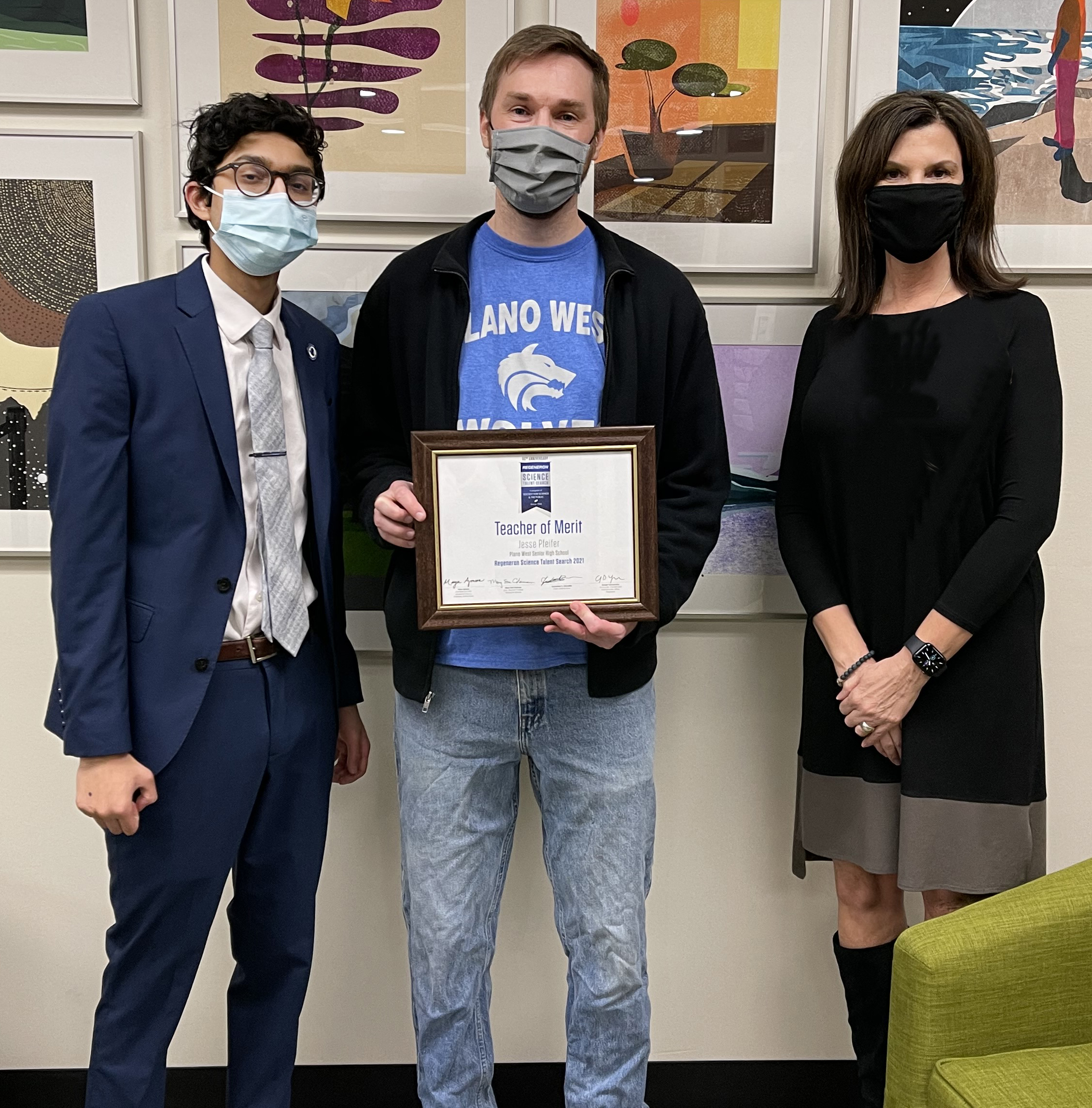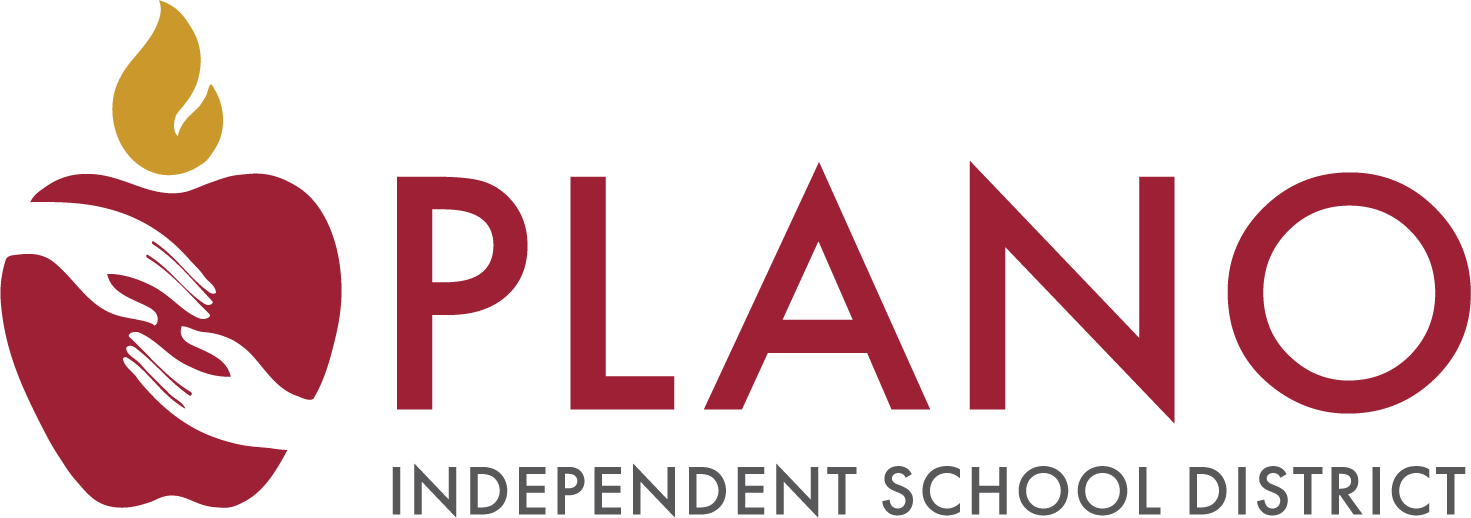- Plano Independent School District
- Plano ISD Headlines
-
Plano West Senior Reaches Top 10 in the Regeneron Science Talent Search
March 30, 2021
-

Alay Shah, a senior at Plano West Senior High School, is a Top 10 winner in the 2021 Regeneron Science Talent Search. Shah finished in seventh place and received a $70,000 award for his research titled, Identifying Eye-Movement Patterns in Neurological Disorders to Assess Cognitive & Motor Function. He developed a tool to test eye movement as a low cost, non-invasive method to quantifying deep brain function. He wrote the software, built the hardware and conducted clinical testing on Dementia, Parkinson's, Multiple Sclerosis, and ADHD patients.
“Besides allowing us to perceive our surroundings, eye movements also act as a window into our mind and a rich source of information about the brain's functions and health. This combined assessment of neurological and psychological health is known as a neuropsychological evaluation, and it proves exceedingly valuable for diagnosing cognitive issues.” Scroll down to read full abstract.
What Inspired Your Research?
Inspiration struck when he noticed medical personnel on the football field sidelines checking players’ eyes for possible concussion – if doctors can make a preliminary diagnosis during a noisy and stressful situation, like a football game sideline, why couldn’t a similar eye test be used to test for other mild traumatic brain injury.
This initial moment of inspiration began a four-year research journey that included independent study and input from teachers and professionals, as well as testing on neurological patients. Retired Plano ISD Secondary Science Coordinator Karen Shepherd who mentored Shah says that, “Alay has a passion for his research and for science in general. He began his research in ninth grade, and he stuck with his hypothesis even when he was told by some experts it couldn’t work. His research became more focused and innovative as his technical expertise expanded to meet his research goals. He was absolutely willing to put in the work, keep trying when things failed and learning what he needed outside of his classwork. He is one of the most motivated and talented researchers I’ve had the privilege to mentor.”
What Was the Most Challenging Part of Your Research?
Shah says the biggest challenge to success was his learning “cliff.” He needed to learn the computer skills necessary and that took a lot of time. “I didn’t know anything about Artificial Intelligence (AI),” he said. He worked through online programs, such as Coursera or MIT’s OpenCourseWare, read books on the subject, and he added to his skills as he went along.
The next big challenge came after his programming skillset was there and his prototype built. How to test on real-world patients. “I did cold calling. I developed a pitch deck to pitch my ideas to private neurological practices to convince them to test my safe, easy to use diagnostic eye tracking tool developed by a 15 year old kid.” That took persistence. And he was successful, eventually, compiling eye-movement pattern data on nearly 200 patients, testing patients with dementia, Parkinson’s and other disorders. “Observing the patients was a great experience,” he said.
What Do You Think Put Your Project in the Top 10?
Competition is fierce for the Regeneron Science Talent Search top prizes. Regeneron scholars and finalists are chosen from thousands of entries based on their exceptional research skills, commitment to academics, innovative thinking and promise as scientists. Shah considers his communication skills to be key in his success. Not only is his project technical, low-cost, well documented and needed, he was able to effectively present his research during interviews. He believes the soft skills of presenting concepts need to accompany the hard science to achieve high-level success.
Volunteer Activities
He enjoys giving back to the science community and is a founding member, along with other Plano ISD students, of the Association for Young Science and Innovators (AYSI). AYSI is a student-lead nonprofit created to help young scientists pursue success with support from more experienced student scientists. Shah is currently co-president and is working to mentor fellow student scientists with their research projects and helping them increase their ability to communicate effectively about their research during judging interviews. He believes that research skills needs to be accompanied by presenting skills. “Success in science competition has three elements: ideation, execution and presentation,” he said.
As founder and president of his Get Back to Work Initiative, Shah has helped fundraise to assist families in India whose primary breadwinner, due to illness or accident, needs new vocational or medical equipment, such as wheelchairs. The Get Back to Work Initiative partners with Lions Club International and a hospital in India.
Awards
Shah is a publish author, a contributor to the Human Brain Project and an award winning researcher. Beyond his 2021 Regeneron awards, his science fair successes include awards at: American Junior Academy of Science, International Science & Engineering Fair and the National Junior Science & Humanities Symposium.
Advice for Students
His advice for future science fair participants is, “Don’t listen to people who say it can’t be done. If you believe it’s there then something is there. Don’t let other's preconceived notions limit innovation. Science is always moving and one success, big or small, can change everything.”
Plano ISD Science Secondary Coordinator Dr. Ashley Carter has this to say about his work ethic and never-give-up attitude, “Alay’s hard work and perseverance are why he has been so successful with his research. He has cultivated a thorough understanding that overcoming challenges is part of the scientific process. If something isn’t working as intended or you discover new information, you make adjustments to your plan or methodology, but you never quit. His belief in himself and his dedication to scientific exploration have served him well. Alay has a bright future ahead of him!"
LASER (Learning About Science & Engineering Research)
Looking back on his Plano ISD academic career, Shah credits the curricular club LASER (Learning About Science & Engineering Research) with keeping him motivated regarding science competitions and research. LASER sponsor and AP Biology Teacher Emily Sharma says that “…during his involvement in LASER, Alay is happy to share his knowledge and experience to help other student scientists excel in their own research and is a role model for students new to science fair. He is continuing the tradition of excellence in science research at Plano West, and the Plano West science department couldn’t be more proud of his accomplishments.”
Thankful for Support of Family, Teachers and Mentors
Shah expressed his thanks to his parents, his brother and his friends; all of whom have been supportive. He also gives a nod of thanks to his Renner Middle School Science Teacher Christina McDuffee who remembers him "...to be a bright spot in the classroom with a passion to learn. It is wonderful to see a student with a love for science be part of such an incredible success story. It touches my heart that Alay feels seventh grade science impacted his interest in science fair. I am extremely proud of Alay and feel confident that he will continue to be a shining star.".
He thanked Plano West Senior High AP Statistics Teacher Jesse Pfeifer, for making learning statistics fun by creating a classroom environment where “learning never feels like work." Shah selected Pfeifer as a Regeneron teacher of merit. Pfeifer is very proud of his student, “Alay’s top 10 Regeneron finish is not surprising at all. His quick-wit brightened our classroom in AP Statistics daily. Alay’s project is so far outside my realm of expertise that it truly inspires a sense of awe. He is very deserving of this award and will undoubtedly continue on to great achievements after high school.”
And he also thanked two of his mentors Dr. Jaya Trivedi a professor in the department of neurology at UT Southwestern and Karen Shepherd, Plano ISD secondary science coordinator (now retired) for their guidance and support.
Alay Shah has attended Plano ISD since third grade at Huffman and Hightower Elementary Schools, Renner Middle School, Shepton High School, and is currently a senior at Plano West Senior High School. After graduation, he plans to continue his studies at either UT Austin or Yale.
-

Alay Shah with his project.

Alay Shah, Plano West Teacher Jesse Pfeifer and Plano West Principal Janis Williams, at Regeneron Teacher of Merit presentation.
Project Abstract
-
Identifying Eye-Movement Patterns in Neurological Disorders to Assess Cognitive & Motor Function
Besides allowing us to perceive our surroundings, eye movements also act as a window into our mind and a rich source of information about the brain's functions and health. This combined assessment of neurological and psychological health is known as a neuropsychological evaluation, and it proves exceedingly valuable for diagnosing cognitive issues. Current standards of neuropsychological assessments pose serious inaccuracies and difficulties in accessibility due to its process of continually monitoring behavior in patients. Computer vision and deep learning are used to tap into the oculomotor biomarker (eye movements) to create a non-invasive, low-cost, and effective approach to quantifying brain functions. The developed tool uses an infrared camera sensor to deploy pupil-tracking and gaze-estimation algorithms that accurately identify abnormal eye sequences in response to visual stimuli. Clinical testing on Dementia, Parkinson's, Multiple Sclerosis, and ADHD patients found that the tool could localize behavioral abnormalities within an 85-second test in all major cognitive areas: memory, movement, coordination, and attention. The pattern recognition engine was able to classify a recurring pattern in each of the four disease groups, including abnormalities like minute tremors and twitches. The biomarker yields sensitivity and specificity rates above 90% for all disease groups, proving this tool's capability in understanding human behavior, intent, and cognitive issues. The data suggests that the developed eye-tracking tool accurately classifies neuropsychological and motor issues, and the easily implementable nature increases viability in broad applications that require an analysis of human interactions with their surroundings.


